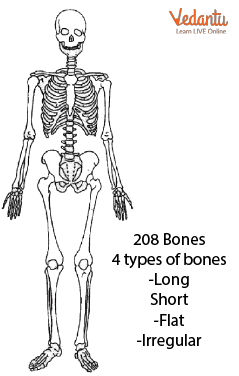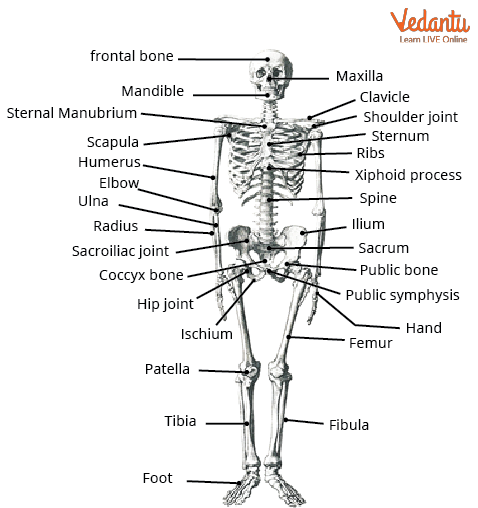




How Does the Skeletal System Support Our Body?
For body movements such as running, swimming, jumping and climbing, we need the help of our bones and muscles. All the bones in our body together form the skeleton system. Our bodies contain 206 bones. Another name for it is the musculoskeletal system. Bone makes up the majority of the skeletons in vertebrates. Each type of animal has a different skeletal structure made up of bones.
Our skeletal system gives our body stability and strength so that we don't just flop around like jellyfish, and also protects our organs. For instance, the rib cage and skull both shield our heart and lungs from harm. Other bones, such as those in our arms and legs, support our muscles and allow us to move around.
Skeletal Types
Fish, amphibians, reptiles, birds, and mammals all have skeletal systems. There are also animals which do not have skeletons inside their bodies such as insects or shellfish. Instead, they have exoskeletons, which are tough external coverings. Coral and sponge skeletons are composed of stony minerals rather than bone. Some creatures, like jellyfish, don't even have skeletons.
On the basis of this, there are two main categories of skeletons - solid and fluid. Solid skeletons can have an exoskeleton (which is external) or an endoskeleton (which is internal), and they can also be pliable (which is elastic and mobile) or rigid (which is hard and immovable). Fluid skeletons are always internal.
1. Exoskeleton
Many invertebrates, including arthropods and molluscs (snails), have external skeletons called exoskeletons that enclose and protect the body's delicate tissues and organs. As an animal grows, several exoskeleton types undergo periodic moulting or ecdysis.
This is the case for many arthropods, such as insects and crustaceans. In addition to providing protection, insects' exoskeletons also operate as a surface for muscle attachment, a waterproof barrier against drying, and a sensory organ for communication.
2. Endoskeleton
Animals have an internal support system called an endoskeleton, which is often seen in vertebrates and is made of mineralized tissue. The role of endoskeletons can range from being solely supportive to acting as a point of attachment for muscles and a means of transmitting muscular forces. Mesodermal tissue serves as the foundation for a real endoskeleton. Echinoderms and chordates both have this type of skeleton.
3. Pliant Skeletons
Since flexible skeletons can move, when skeletal tension is applied, they can deform before regaining their original shape. Some invertebrates utilise this skeletal structure, such as the hinge on bivalve shells and the mesoglea in cnidarians like jellyfish.
4. Rigid Skeletons
Strong support systems are more prevalent in terrestrial animals because rigid skeletons cannot shift under stress. This sort of skeleton is more protective or employed by animals that move quickly and need extra support for their muscles to swim through water.
Human Body Skeleton
The internal skeleton that supports the human body is called the human skeleton. This framework is made up of numerous separate bones and cartilages. In close contact with the components of the skeleton are bands of fibrous connective tissue as well as ligaments and tendons.
Similar to other vertebrates, humans have two main subdivisions of the skeleton, each of which has a unique origin and unique characteristics. They are axial, which includes the vertebral column, the spine, and a large portion of the skull, and the appendicular, which includes the pelvic (hip), pectoral (shoulder), and limb bones and cartilage.

Skeleton Body of Human
Skeleton and Bones
Typically, the adult human skeleton has 206 named bones. The vertical axis of the body is formed by the 80 bones of the axial skeleton. The free appendages and their connections to the axial skeleton are part of the 126-bone appendicular skeleton. The top and bottom extremities, often known as limbs, with their girdle-like linkages make up the free appendages.
Physiology of the Skeletal System
The skeletal system's main purposes include movement, support, defence, blood cell creation, mineral storage, and endocrine regulation.
1. Support
The skeletal system's main purpose is to give the body and its organs a sturdy framework for support and protection. This aids in preserving the general human body shape.
2. Protection
By serving as a cushion, the skeletal system also contributes to the protection of our delicate interior organs and other bodily structures, such as the brain, heart, and spinal cord. The ribs protect our heart and lungs, the vertebrae protect our spinal cord, and our cranium (skull) protects our brain and eyes.
3. Movement
Bones offer the fundamental framework for muscles to adhere to our bodies to move.

Human Skeletal System With Labelling
Summary
The skeleton system offers a structure that supports and shields the body's organs, thanks to its moving joints. This web of bones is active and interacting with other bodily systems, far from being dry or dead. Deep inside the bones, in the bone marrow, millions of brand-new blood cells are produced every second. Muscle and bone are connected by sturdy cables. Bones can move when muscles pull them.
FAQs on Skeletal System Explained for Students
1. What is the skeletal system?
The skeletal system is the internal framework of the human body, composed of all the bones, cartilages, and ligaments. It provides a rigid structure that gives the body its shape, supports its weight, and works with the muscular system to allow movement.
2. What are the five main functions of the skeletal system?
The skeletal system performs several critical functions for the body. The five main functions are:
- Support: It provides a structural framework for the body, supporting soft tissues and providing points of attachment for most skeletal muscles.
- Protection: It protects vital internal organs from injury. For example, the skull protects the brain, and the rib cage protects the heart and lungs.
- Movement: It works in conjunction with muscles to enable body movement. Bones act as levers, and joints act as pivots.
- Mineral Storage: Bones serve as a reservoir for minerals, primarily calcium and phosphorus, which can be released into the blood when needed.
- Blood Cell Production: The marrow inside some larger bones produces red blood cells, white blood cells, and platelets in a process called hematopoiesis.
3. How are the 206 bones in an adult human organised?
The 206 bones of the adult human skeleton are organised into two main divisions:
- The axial skeleton, which forms the central axis of the body. It includes the skull, the vertebral column (backbone), the ribs, and the sternum (breastbone).
- The appendicular skeleton, which includes the bones of the limbs (arms and legs) as well as the pectoral (shoulder) and pelvic (hip) girdles that attach the limbs to the axial skeleton.
4. What is a joint, and what are some examples of different types in the body?
A joint is a point in the body where two or more bones meet, allowing for movement. Different types of joints allow for different ranges of motion. Key examples include:
- Ball-and-Socket Joint: Allows movement in multiple directions. Examples are the shoulder and hip joints.
- Hinge Joint: Allows back-and-forth movement in one direction, like a door hinge. Examples are the elbow and knee joints.
- Pivotal Joint: Allows for rotational movement around an axis. An example is the joint between the neck and the head.
- Fixed Joint: Allows no movement at all. The bones of the skull are connected by fixed joints.
5. What is the difference between a bone and cartilage?
Bone and cartilage are both connective tissues, but they differ in their properties and functions. Bone is a hard, dense, and rigid tissue that is rich in calcium; it forms the main structure of the skeleton for support and protection. Cartilage is a firm but flexible tissue that is not as hard as bone. It covers the ends of bones at the joints to provide a smooth, cushioned surface for movement and also gives shape to flexible parts like the ears and nose.
6. Why can't we bend our elbow backwards or our knee forwards?
We cannot bend our elbow backwards or our knee forwards because they are hinge joints. The shape of the bones and the arrangement of ligaments in a hinge joint are specifically designed to restrict movement to a single plane, like a door hinge. This structure provides stability and allows for strong, controlled bending and straightening but physically prevents movement in the opposite direction.
7. How do muscles and bones work together to cause movement?
Muscles and bones work together as a lever system to create movement. Muscles are attached to bones by tough, fibrous cords called tendons. When a muscle contracts, it pulls on the tendon, which in turn pulls the bone, causing it to move at a joint. Muscles typically work in pairs; while one muscle contracts to move a bone, its opposing muscle relaxes.
8. Are bones considered living tissues? Explain why.
Yes, bones are very much living tissues. Although they feel hard and inert, they are dynamic organs with their own network of blood vessels, nerves, and living cells. These cells allow bones to grow during childhood, repair themselves after a fracture, and constantly remodel by breaking down old tissue and forming new tissue throughout a person's life.









